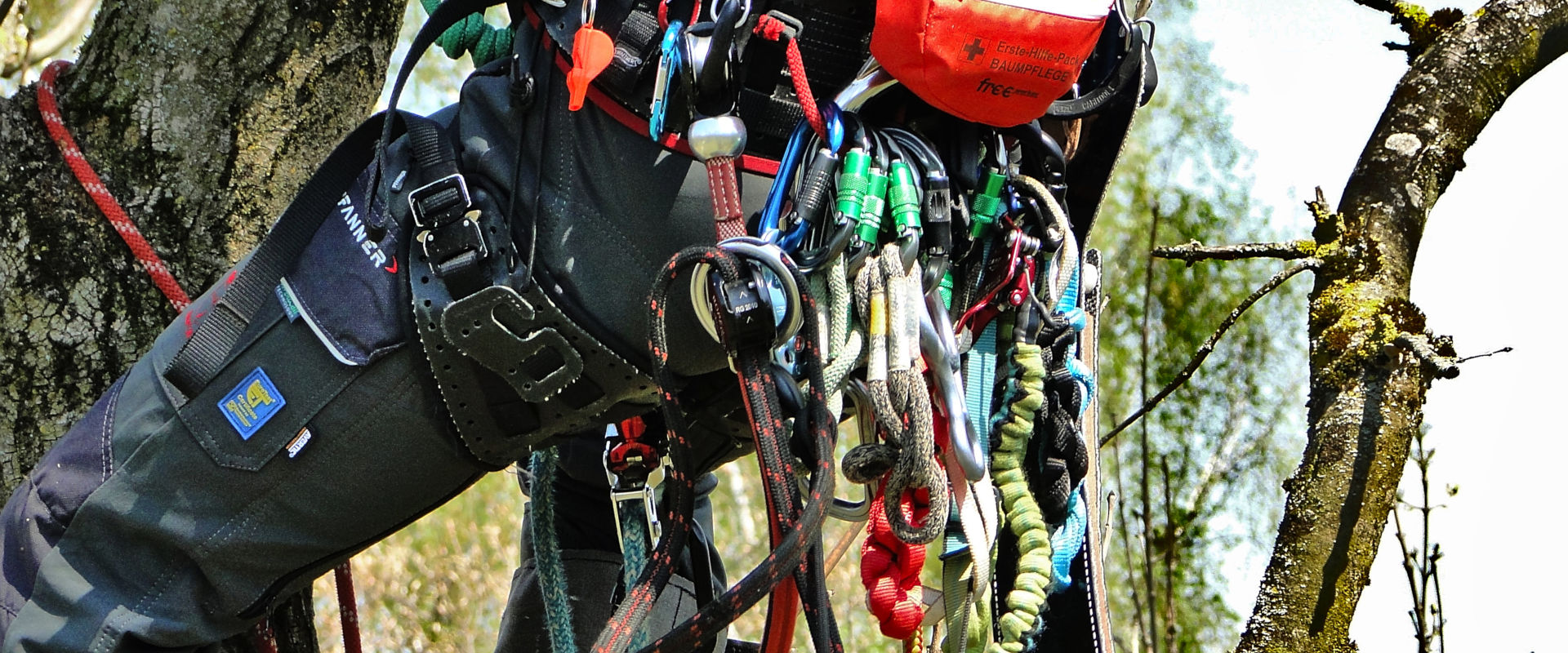Carabiners play a very important role in tree care and tree climbing. They are the fundamental connectors between the individual components of the climbing system. They are also useful helpers when securing material, e. g. to the climbing harness. Carabiners come in different shapes, with different closures and for many purposes. Which shape and which closure are suitable when and where in tree care and tree climbing?
Which standards apply to carabiners in tree care?
In professional tree climbing, carabiners approved according to EN 362 (in German and English, PDF) and/or EN 12275 (in German and English, PDF) are generally used. EN 362 deals with personal fall protection equipment – connectors, EN 12275 with mountaineering equipment – carabiners. This only applies to carabiners that are part of the personal protective equipment (PPE) and are used for personal safety. Carabiners without the corresponding certification are used by arborists, for example, to secure their equipment.
Carabiners that are part of the PPE used in tree climbing should fulfil three important conditions:
- The carabiner can only be opened with three independent movements.
- The closure closes and locks automatically.
- The minimum breaking strength is 20 kN.
Different types of carabiner closures
Snap carabiners
This type of closure is very common in mountaineering. Climbers also use them for belaying. In tree climbing and industrial climbing, these carabiners are not permitted because they do not have an additional safety mechanism. Therefore, they are only used in tree climbing for equipment or similar.
Screw carabiners
It usually takes longer to open these carabiners. This is why arborists often use them where the carabiner is not constantly opened and closed.
Snap hook carabiners
The closure is operated by the ball of the hand and the fingers. They are two-way carabiners. These carabiners can be opened quickly and are often used on via ferratas or for scaffolding work. In tree climbing, they are used for safety lanyards.
Trilock
This type of closure is best for PPE carabiners in tree care. There are various technical solutions for the three-way closure or triple lock. The most common is the following: First you have to push on the locking sleeve and then turn it before the closure can be opened.
More solutions for Trilock carabiners
Another technical solution is the Ball Lock closure. This is a mechanism patented by Petzl that turns the carabiners into safe lock carabiners. Only when the climber presses the green ball can the locking sleeve be turned and the carabiner opened. The carabiner is not locked properly until the green ball is visible. A small disadvantage of this clever system: it takes a little practice to open the Ball Locks when wearing gloves.
DMM has also developed its own solution: 4-way carabiners with the Durolock principle. Four different movements are necessary to open the carabiner. This provides an additional plus in safety when tree climbing and can be done with one hand.
What does keylock mean?
Keylock literally means keyhole closure. The name comes from the specific shape of the lock between the gate and the carabiner, which is reminiscent of a keyhole. The nose of the carabiner has a thickening at the tip, the negative of which is found in the gate. Like a key and a keyhole, both fit perfectly into each other.
Unlike other solutions, this system does not have any hooks or similar that can catch ropes or webbing slings during insertion or release. In addition, there are no sharp edges that could damage the tree climbing rope. Nevertheless, it closes just as reliably as the classic “hook and pin” systems.
Breaking strength for PPE carabiners in tree care
The minimum breaking strength of 20 kN refers to correctly closed carabiners and to longitudinal loading. If the carabiner is open or is loaded transversely, the breaking strength is reduced considerably. To prevent the breaking strength from being reduced or the carabiner from failing in the worst case, the following must be observed when tree climbing:
- Transversal load
- Bending or rotational load
- Pressure on the locking sleeve
- Blocking of the automatic closure
These points can be eliminated by an appropriate climbing technique and a suitable fixation of the carabiner. For the latter, there are various aids such as special carabiner fixations. In addition, some carabiners have a Captive Bar. This is a screwable fixing pin that prevents cross-loading. Some have a small hook on the back. This reduces the risk of pulleys and belay devices jamming. Because that can also lead to transversal loading.
Which material is best for tree care carabiners?
When selecting the appropriate material, the area of use and the weight play an important role. PPE carabiners are either made of steel or aluminium. These materials are particularly strong and have a high breaking strength. Tree climbers usually use aluminium carabiners. They are much lighter than steel carabiners and every gram counts when climbing. On the other hand, steel is much stronger than aluminium. That is why steel carabiners are often used for rigging.
Different shapes of carabiners
D-shaped carabiners
The asymmetric D shape ensures optimum load distribution along the spine, where the carabiner is strongest. This shape is particularly suitable for connecting to descenders or anchor points. In addition, this shape reduces the risk of the carabiner turning unintentionally, thereby positioning itself incorrectly and being transversely loaded.
Oval-shaped carabiners
These carabiners have an almost symmetrical shape. This distributes the load evenly. They are versatile and can be combined well with other devices and connectors.
HMS or “pear-shaped” carabiners
HMS is the acronym for “Halbmastwurf-Sicherung” which is German for belaying with a Munter hitch. This carabiner shape was developed for lead belaying using the Munter hitch. The wide side provides space for the hitch, while the narrow part provides good stability for the attached lanyard.
Accessory carabiners for the harness
For tree care and tree climbing, there are special accessory carabiners that are hooked or attached directly to the climbing harness and remain there. The suspension for the harness is on the back of the carabiner and ensures that the carabiner stays in position. In this way, material such as the chainsaw can be hooked in easily and safely when it is not needed.
Special designs with swivel, eye, pulley, etc.
Another special feature are carabiners with integrated swivels, pulleys or eyes. Ropes, for example, can be inserted or spliced directly into them. They are often used for safety lanyards or redirections. They are also used on rope bridges.
A little tip
It doesn’t always have to be a large carabiner to secure your equipment. Small, compact carabiners are perfect for smaller devices or gear. They are available in many different colours. This way you always have an overview and your equipment is clearly organised on the harness.
What care does a carabiner need?
Like any other tool, carabiners need some care now and then – especially if they are very dirty or stiff. We recommend washing the carabiners in lukewarm water (approx. 30° C), if necessary with a neutral cleaning agent and e. g. with the help of an old toothbrush. Then rinse the carabiners with clean water. When drying, avoid direct sunlight or other sources of heat such as a heater. When the carabiner is completely dry, a drop of penetrating oil on the clasp or the moving parts definitely does no harm.
More articles on the Freeworker blog
- 3-way carabiners: Accidental opening
- Working load vs. breaking load: Important difference
Freeworker, Equipment for Tree Care and Rope Technology
Fast – Professional – Reliable













